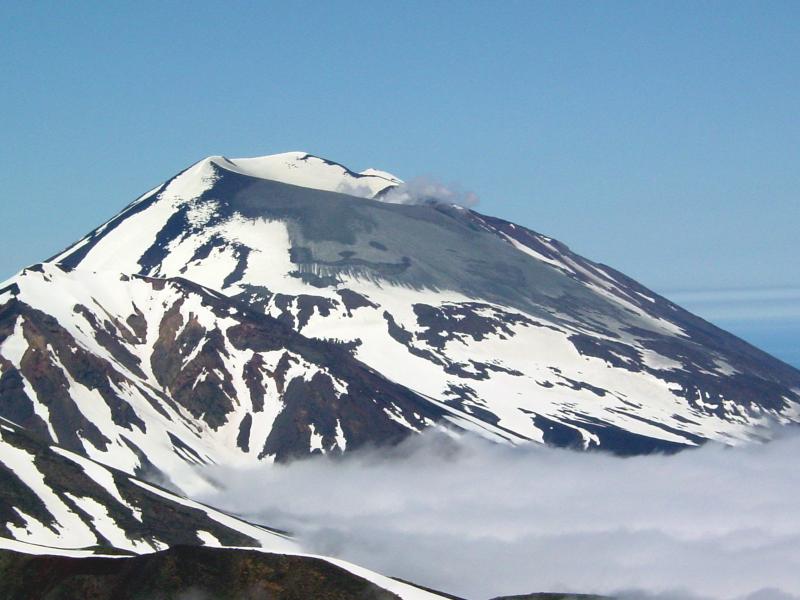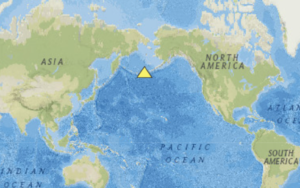
Four the 4th time in the last 7 days, scientists are raising the alert level for another volcano in the U.S. as the risk of a fresh volcanic eruption rises. The Alaska Volcano Observatory (AVO) is raising the Aviation Color Code and Alert Level at the Atka volcanic complex to YELLOW/ADVISORY after detecting an increased number of small, shallow earthquakes over the past 24 hours. According to the AVO, these earthquakes have been located 1.9 to 3.7 miles deep; they’ve been centered around 4.3 miles southwest of Korovin Volcano. According to the AVO, the earthquakes represent an increase from background seismic activity, but may not necessarily lead to an eruption.
Previous alerts by the Alaska Volcano Observatory for unrest for the Atka volcanic complex have been for Korovin Volcano, the site of the most recent historical eruptions. The location of earthquakes, however, is not specific to Korovin and could be related to several other volcanic vents that are part of the Atka volcanic complex, including Mount Kliuchef.

The Atka volcanic complex’s increased volcanic alert level join three others in Alaska showing recent increased activity. Within the week, AVO highlighted the alerts that are now in effect for Semisopochnoi, Pavlof, and the Great Sitkin volcanoes. The Cleveland volcano has also been showing activity lately too.
The Alaska Volcano Observatory says they will continue to monitor the Atka volcanic complex for signs of volcanic activity. The area is monitored by local seismic and infrasound sensors, satellite data, and regional lightning detection instruments.
Within the United States, the USGS tracks 169 potentially active volcanoes, most of which are in Alaska. Alaska is home to many volcanoes, though; there are more than 130 volcanoes and volcanic fields which have been active within the geologically young last 2 million years. 50 have been active since the mid 1700s and AVO studies those too. Another place famous for its volcanoes is Hawaii; on the Big Island of Hawaii, Kilauea, Mauna Loa, and Hualalai are considered active and potential threats, however none are erupting as of today. Kilauea did start a fresh eruption in December 2020, but that eruption came to an end just weeks ago. The Hawaii volcanoes are monitored by the Hawaii Volcano Observatory (HVO) while the Alaska volcanoes are monitored by the Alaska Volcano Observatory (AVO.) In addition to the AVO and HVO, there are also the California Volcano Observatory , Cascades Volcano Observatory, and the Yellowstone Volcano Observatory. Each of those additional volcano observatories within the USGS are monitoring volcanoes in their respective regions. At this time, none of those other observatories are reporting unusual activity or signs of anything more than background noise for now.
According to the U.S. Geological Survey (USGS), there are about 1,500 potentially active volcanoes worldwide, with about 500 of the 1,500 erupting in historical times. Most of the volcanoes in the world are located around the “Ring of Fire” around the Pacific Rim. The Ring of Fire is a region around the rim of the Pacific Ocean where many volcanic eruptions and earthquakes occur. Caused by plate tectonics, lithospheric plates under and around the Pacific Ocean move, collide, and/or are destroyed, creating the seismic activity the Ring of Fire is famous for.
In the U.S., the USGS and volcano observatory units are responsible for issuing Aviation Codes and Volcanic Activity Alert Levels. Aviation Codes are green, yellow, orange, or red. When ground-based instrumentation is insufficient to establish that a volcano is at a typical background level of activity, it is simply “unassigned.” While green means typical activity associated with a non-eruptive state, yellow means a volcano is exhibiting signs of elevated unrest above known background levels. When a volcano exhibits heightened or escalating unrest with the increased potential of eruption, it jumps to orange. Finally, when an eruption is imminent with significant emission of volcanic ash expected in the atmosphere or an eruption is underway with significant emission of volcanic ash into the atmosphere, the code becomes red. Volcanic Activity Alert levels are normal, advisory, watch, or warning. As with aviation codes, if data is insufficient, it is simply labeled as “unassigned.” When the volcano is at typical background activity in a non-eruptive state, it is considered normal. If the volcano exhibits signs of elevated unrest above background level, an advisory is issued. If a volcano exhibits heightened or escalating unrest, a watch is issued while a warning is issued when a hazardous eruption is imminent.